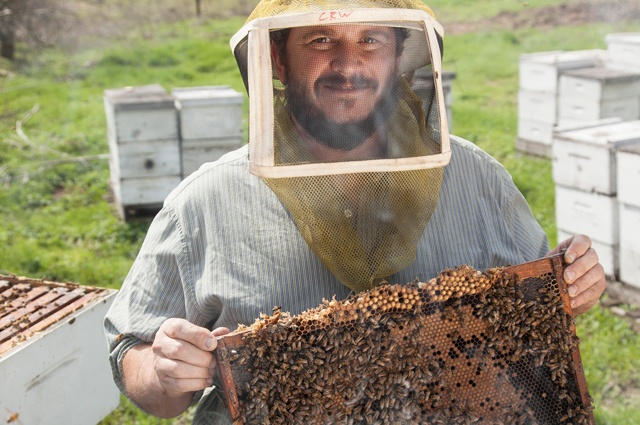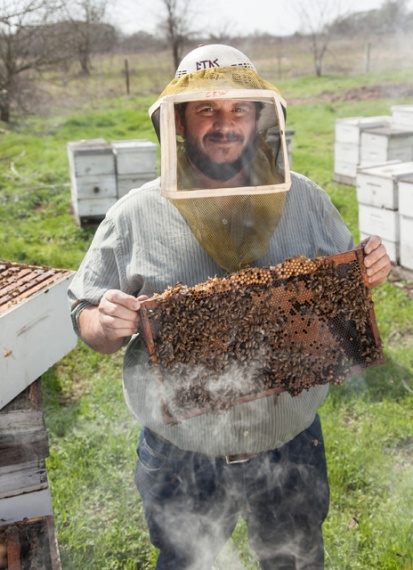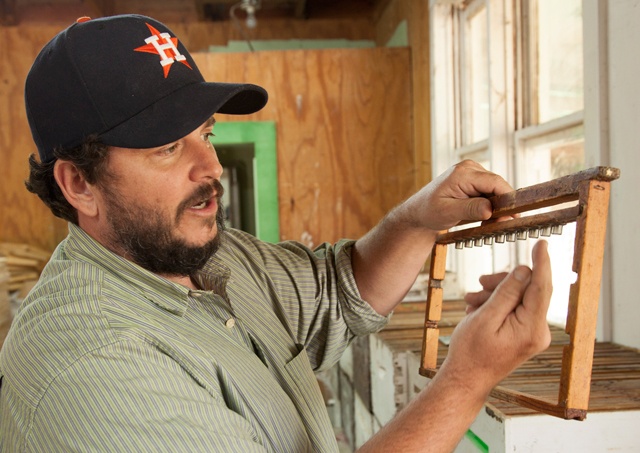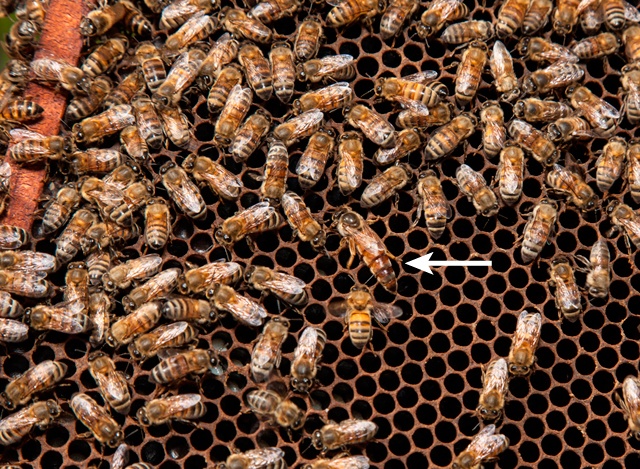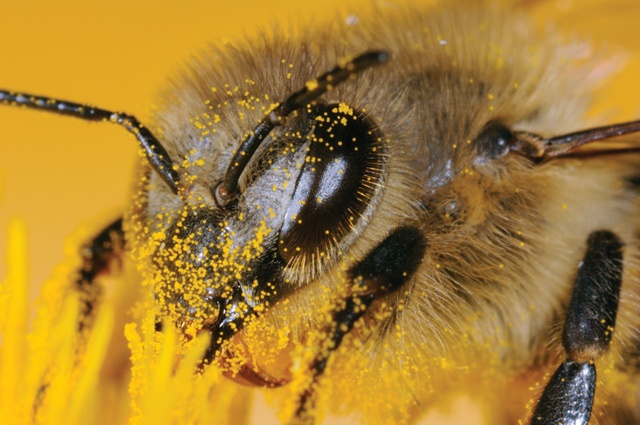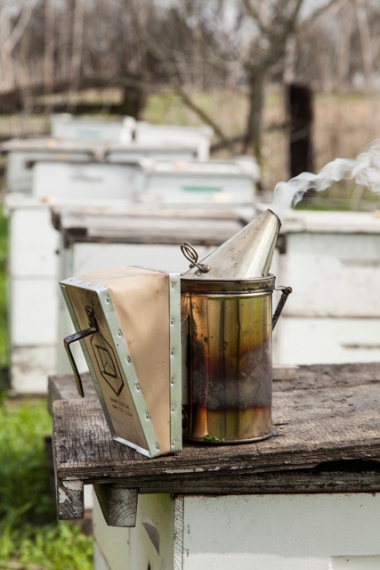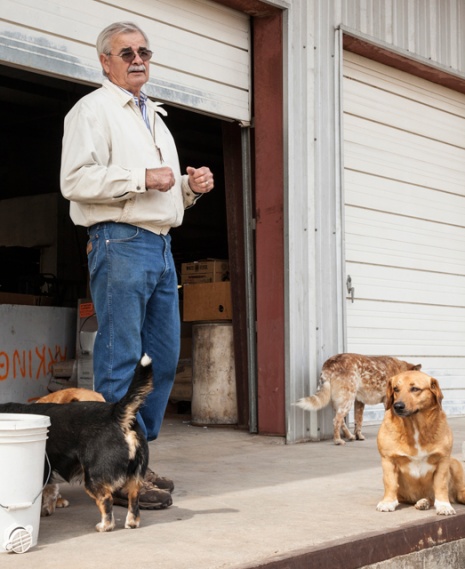Pulling out a rectangular frame from a boxy wooden beehive, Clint Weaver is unperturbed as hundreds of bees zoom out, their combined buzzing creating an unearthly, vibrating wave of sound. He points out the swollen form of the queen bee amid her thousands of offspring and doesn’t even wince when he gets stung on the thumb.
“Bees blow my mind every day. Every spring, there’s a new excitement,” Weaver says. “I love it. This is a beautiful job.”
It’s a job he was born to do. R Weaver Apiaries, the company Clint Weaver owns and operates with his father, Richard Weaver, in Navasota, originated 125 years ago.
In 1888, Clint Weaver’s great-great-grandparents Zachariah and Florence Weaver were given 10 hives of bees as a wedding present. They expanded the number of hives they owned, and then their son, Roy Weaver Sr., took over. He was followed by Roy Weaver Jr., then Richard and now Clint. In 1926, Roy Weaver Sr. was approached by T.W. Burleson, founder of Burleson’s Honey, who requested at least 1,000 queens a year. Weaver Apiaries was born.
Today, R Weaver Apiaries’ primary business is selling queen bees to commercial beekeepers. R Weaver develops the queens by removing larvae from the hives and feeding them royal jelly. Other beekeepers buy the queens, so when they split a large number of hives, they have the number of queens they need. The price for one All-American Queen is $26, or $18 each for 100 or more. In addition, the Weavers sell everything a hobbyist would need to get started. You can order bee “veils” (the screened masks beekeepers wear), helmets, leather gloves, bee smokers, wooden hives and frames, as well as the bees themselves, roughly 10,500 bees in every 3-pound package.
Big Business
Bees and honey are big business. Bees and pollination services contribute $589 million a year to the Texas economy, says Blake Shook, president of the Texas Beekeepers Association. Shook, a member of Grayson-Collin Electric Cooperative, is the owner of Desert Creek Honey in McKinney, where his company bottles and sells its honey.
“A vast majority of honey on box store shelves says it is local, raw and unfiltered, and in fact it is none of those things,” Shook says. “That’s really hurting local beekeepers.” A good place for consumers to buy honey is their local farmers markets and at texasbeekeepers.org, where there soon will be an interactive map so people can find their closest local honey producer, he says. The association is working on establishing standards so the labels “raw” and “local” on honey will have more validity.
Honeybees pollinate 80 percent of all fruit, vegetable and seed crops in the United States, according to the National Honey Board (honey.com).
Most people have no idea how much their daily diet depends on honeybees, says wildlife biologist and beekeeper Dennis Herbert, owner of Conservation One, a wildlife and land management services company.
“All of your apples, blueberries, watermelon, cantaloupe, vegetables, citrus fruits—all of those are bee-dependent,” Herbert says. “All the things that make living and eating our foods enjoyable depend on bees.”
Every year, in fact, many commercial beekeepers from Texas and elsewhere haul their bees to California to pollinate almond trees. Some also travel to other states to pollinate cranberry and blueberry crops.
Shook owns about 2,000 hives. He recently transported 75 percent of them to almond groves in California. “Almonds are incredibly dependent on bees for pollination,” he says. “With bees, an acre of almond trees can make two to three thousand pounds of almonds. Without bees, the same acre would only produce two to three hundred pounds.”
Thus, there is a tremendous demand in California for bees and not enough bees in the state to handle the workload. So the bees make the trip on big flatbed trucks—400 hives to a flatbed. Shook and his staff load them at night when they’re asleep, place a net over them and head west. They leave the bees there to pollinate for about a month and a half. During that time, the almond trees’ 10- to 12-day blooming period occurs.
A beekeeper works hard all year, Shook says. In the spring, the hives are split (this means taking some of the bees out of each hive and creating a new hive with a new queen.) Summer is the time to harvest honey from the bees and make sure they have enough water. In the fall, beekeepers make sure the bees have plenty of honey to prepare them for winter. In the winter months, bees need to be kept out of the wind. Beekeepers start feeding their bees in January.
“Beekeepers are incredibly resilient and creative,” Shook says. “They are good at overcoming challenges.”
Losses to CCD and Varroa Mite
Those challenges have been considerable in the past 20 years. Colony collapse disorder, or CCD, has devastated bee colonies around the world, including in Texas. The main symptom of CCD is a hive with a live queen but very few or no adult honeybees present, according to the U.S. Department of Agriculture.
The total number of managed honeybee colonies in the United States has dropped from 5 million in the 1940s to 2.5 million today, according to the USDA.
“One year you can have great hives that have 60 or 70 thousand bees,” says Herbert, a member of Bartlett Electric Cooperative. “Then over the winter you may lose half of them to colony collapse disorder.”
Bill Baxter is assistant chief apiary inspector for Texas A&M AgriLife Research. He is also a beekeeper and longtime member of Navarro County Electric Cooperative.
“A lot of beekeepers in Texas have lost 50 to 60 percent of their colonies because of colony collapse disorder,” Baxter says.
Many people, including Herbert, think CCD is linked to the use of a class of pesticides called neonicotonoids. “In countries where neonicotonoids have been banned, it is improving for the bees,” Herbert says.
Baxter is more circumspect. “They still don’t know what causes CCD,” he says. “There are a lot of different ideas, and a lot of universities and organizations are studying that.”
Varroa mites, a parasite of honeybees, are frequently found in hives suffering from CCD. The mite attacks adult bees and developing larvae.
The Weavers have firsthand experience with the varroa mite. In early 2000, they bought a truckload of bees that they didn’t realize was infested with varroa mites. The deaths of the bees from the infected hives cost them $35,000.
“We came real close to losing our business,” Clint Weaver says. “That’s a big lick for a tiny company.”
The devastation from CCD might be abating. Total losses of managed honeybee colonies were 21.9 percent nationwide for the winter of 2011-12, according to the USDA. This is substantially less than the mortality rate of the previous five years. However, scientists are not sure whether the improvement is due simply to a warmer-than-average winter or to progress against the disease.
Are Beekeepers a Dying Breed?
At only 23 years old, Shook is an anomaly among beekeepers. What is now a large and thriving business started when, at the age of 12, he won a beehive and equipment from a local association in McKinney. By the time he graduated from high school, he had a decent-sized business with about 350 hives.
Nationally, “only 5 percent of commercial beekeepers in the United States are under 40,” Shook says. “That trend gets worse every year. It’s a hard job, with long hours, and you need lots of knowledge about a huge variety of things.” That includes knowing how to manage the financial aspect of the business as well as the knowledge about entomology and agriculture needed to care for the bees and increase their honey production.
Having five generations of Weavers maintain the family business means, of course, that each succeeding generation chose to do what his father and grandfather did before him. That wasn’t always a sure thing for Richard Weaver. When he was 20 years old—back in the early 1960s—he decided to move to Houston and pursue a life there. He lasted six months.
“I missed living in the country,” Richard Weaver says. When he came back, he started learning the business. “I certainly didn’t come in thinking I knew everything,” he recalls.
How much did his dad pay him per hour? He laughs. “Fifty cents.”
Clint Weaver also had years when he didn’t know whether he wanted to follow in the family footsteps. In high school, he didn’t want to be a beekeeper, he says. Then one summer when he was in college, he came back to work at the bee farm. “When I really understood beekeeping, I fell in love with it,” he says. “It’s a fascinating job. It’s art; it’s science.”
The next generation of the Weaver family is only 5 years old. Clint Weaver’s daughter, Lela, has said she wants to be an astronaut or a dancer. “I keep asking her if she wants to raise queen bees with Dad,” he says. “It’s a hard way to make a living, but it’s a fun way.”
——————–
Michele Chan Santos is an Austin writer.
